Sixty years ago this month the report of the ‘three wise men’ on promoting non-military cooperation and strengthening unity within the Alliance was issued. What lessons can we draw from this report in the turbulent world of 2016, when many of the fundamentals of transatlantic cooperation and western liberalism are again being questioned?
Our modern age has developed a cult of anniversaries. Each new year brings opportunities to recall events that took place many years previously. 2016 has been no exception. We have recalled titanic events of the First World War, such as the battle of the Somme, but also more distant moments such as the Great Fire of London and the San Francisco earthquake. Yet the present can also be historic. 2016 is turning out to be a momentous year, with the Brexit vote in the United Kingdom and the unexpected election of Donald Trump as US President – events which historians will analyse for many years to come.
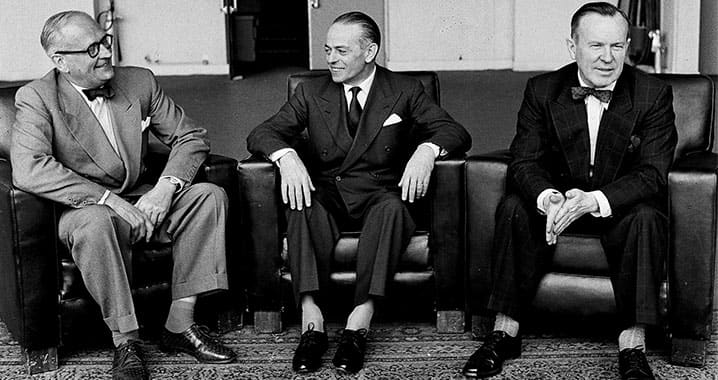
(From left to right) The ‘three wise men’ Halvard Lange, Gaetano Martino and Lester B. Pearson – the foreign ministers of Norway, Italy and Canada, respectively. © NATO
So why – between the invocation of the past and our obsession with an anxious present – should readers of the NATO Review spare a few minutes to reflect on the report of three former foreign ministers that was adopted by the North Atlantic Council 60 years ago this month (December 1956)? Apart from an historical “fait divers”, what does this report say about the state of the Alliance today? The definition of a significant event is not only that it had a deep and lasting impact at the time but also that it continues to be a trove of lessons for our own times.
How to strengthen Allied unity
In May 1956, Halvard Lange from Norway, Lester B. Pearson from Canada and Gaetano Martino from Italy were tasked to “advise the (North Atlantic) Council on ways and means to improve and extend NATO cooperation in non-military fields and to develop greater unity within the Atlantic Community.” Their recommendations resulted in new procedures being instituted for political consultation within the Alliance.
This was the heart of the three wise men’s report: the need for NATO to be not only a military pact but also to take on an increasingly important political role beyond the scope of military planning and force generation, and to debate international political developments to better anticipate risks and opportunities for collective Alliance diplomacy.
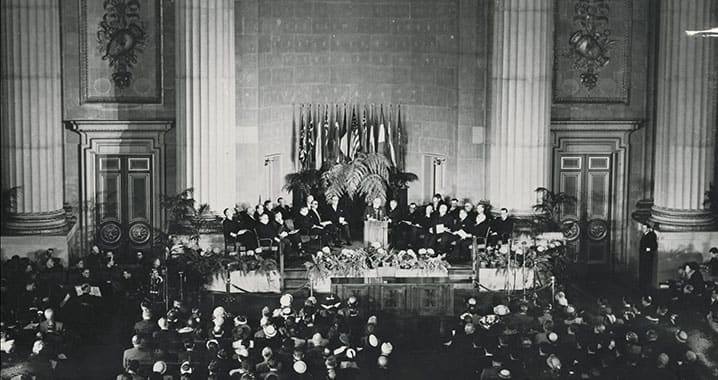
The North Atlantic Treaty, signed in Washington D.C. on 4 April 1949 by twelve founding member states, already foresaw the need for more political consultation and a broader approach to security within the Alliance. © NATO
The impetus for the report came from the medium-sized and smaller nations of the Alliance who, by the early 1950s, felt that their influence was marginalised by the domination of the big “three” – the United States, the United Kingdom and France – who tended to dominate discussions and impose their view points. This may have been natural at the time, given their overwhelming military contributions to NATO’s collective defence but the risk was that this imbalance in NATO would progressively disincentivize smaller Allies from sharing the military burden or demonstrating political solidarity in crisis situations.
The founding fathers of NATO in the late 1940s had correctly foreseen that, if NATO remained a military structure and failed to develop a real sense of common interests and values among its members, it would fade, especially if the imminent threat from the Soviet Union was seen to diminish over time. For that reason, Canada inserted Article 2 into the North Atlantic Treaty to provide for economic cooperation. In 1951 an earlier group of wise men had attempted to link the economic capabilities of Allies more to NATO’s military needs. Yet, by the mid-1950s, not much had come of these efforts. NATO was more a military upholder of the status quo than a force to shape the future of Euro-Atlantic security. Therefore the Committee of Three on Non-Military Cooperation in NATO – as the three wise men’s group was formally called – was a second effort to fix the problem.
More consultation and wider cooperation
No Ally should go it alone. Standing together politically is also the best form of military deterrence.
Their report was truly a breakthrough, even if it took time for the recommendations on enhanced consultation to seep into the Alliance’s DNA. The Allies committed to greater transparency and earlier consultation about their national policies. They agreed to put collective NATO interests above their immediate concerns and to ensure that these did not undermine the Alliance’s collective interest. They gave the Secretary General a greater role to set the agenda or intervene in disputes among Allies, something which later Secretaries General made abundant use of, for instance in mediating disputes between Greece and Turkey in the Aegean, or the United Kingdom and Iceland over fishing.
For the first time structures were established, notably a Committee of Political Advisors to better prepare for political consultations among Ambassadors. The Secretary General was even tasked to produce an annual political appraisal on the state of the Alliance, an idea that lapsed but was revived later by Secretary General Anders Fogh Rasmussen and his successor, Jens Stoltenberg, in the form of an annual report.
The report of the three wise men did not establish a formal Atlantic community, as its tasking had proposed. Ideas for cultural cooperation among Allies or more economic coordination either fell flat or were later taken up by other institutions, particularly after the emergence of the European Economic Community in the late 1950s. But the three wise men did launch a programme to promote scientific and technological cooperation among Allies and to transfer technology and know-how from the more advanced to the less advanced Allies. This has survived remarkably well and is now known as the Science for Peace and Security programme, endowed with a budget of €12 million and which these days develops cooperation among NATO member states and partner countries on issues as diverse as demining, water management and the destruction of chemical and biological substances.
Winning public support and understanding
A second innovation was the sense that NATO required public support and greater public understanding of its mission, if it was to thrive in the long run. This led to the establishment of national information programmes led by dedicated staff.Today this continues as “strategic communications” – an area of growing priority for NATO as our publics are increasingly exposed to multiple news outlets, propaganda, counter—narratives and deliberate fake news in the social media. In this more contested and even confrontational environment, effective communications are vital if NATO is to persuade its nations to make greater efforts for their defence and to defend democratic values at a time when these are no longer accepted without challenge.
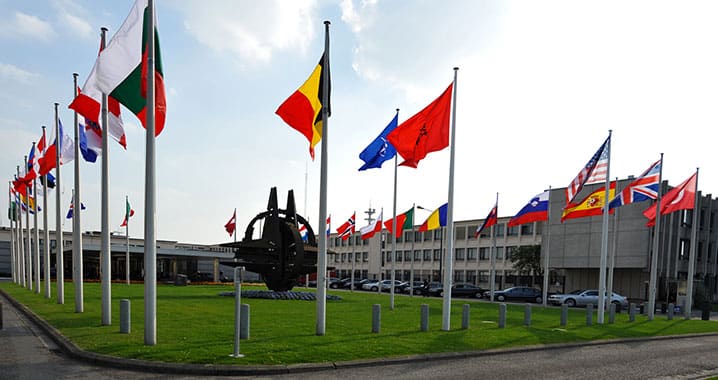
Currently NATO has 28 member countries with Montenegro on the verge of joining. © NATO
Four elements, which were perhaps less explicitly stated or foreseen by the report’s authors in 1956, have now emerged as its true and lasting legacy.
Political unity: the best deterrent
First, that no Ally should go it alone. Standing together politically is also the best form of military deterrence. The wise men stressed that Alliance unity was the best guarantee that its individual policies would ultimately succeed. The purpose of consultation was to ensure that through consensus, no Ally could be excluded or marginalised and each would more readily join the consensus to the extent that it felt its voice had been heard during the discussion. Consensus-building would therefore not be an automatic or easy process. But ultimately consensus would endure because each Ally felt that it could identify with the common position that emerged.
In the 36 years that I have been at NATO I have seen at first hand that, when NATO decides, it shows staying power: 17 years in Kosovo, 13 years in Afghanistan and nine years in Bosnia. When I was NATO Spokesman in the 1990s and had to handle the Kosovo crisis, I was struck by the fact that NATO’s solidarity and unity brought the Serbian leader Slobodan Milosevic to the negotiating table even faster than the impact of its airstrikes. The three wise men’s intuition, to paraphrase Benjamin Franklin, that “We either hang together or we hang separately” is one that NATO has well digested.
Balancing interests and responsibilities
The second lesson is that NATO has to balance the interests of the larger and smaller Allies and give them all a stake, in terms of responsibilities and benefits, in NATO membership.
To survive and thrive, NATO had to become less rigid and more adaptable.
When the wise men set out on their work, NATO had 15 members. Today it is on the verge of 29 and the majority of Allies that have joined since the end of the Cold War have been relatively small countries; for instance the Baltic States, the Czech Republic, Slovenia, Slovakia and Montenegro. But they all have their history, regional perspective and particular way of dealing with their neighbours, which can benefit NATO diplomacy. They can make effective military contributions if they are linked to a good NATO planning process or, for instance, the recent concept of Framework Nations, which encourages groups of Allies to work together on a multinational basis to develop forces and capabilities required by the Alliance, guided by a framework nation. This gives smaller Allies a niche role in providing important military capabilities.
The wise men rightly identified that NATO’s key to success would be to balance everyone’s interests and priorities while establishing a framework for common action. Never has this principle been more fundamental than it is today, as NATO has to tackle the very different security challenges from the East and the South, without losing its cohesion or its ability to influence events.
Deterrence and dialogue
The third major lesson from 1956 is that military strategies can prevent wars in the short-term but cannot remove the factors that cause tension. It is too risky to rely on military deterrence alone. By adding political cooperation to NATO’s core tasks, the wise men recognised that only a political strategy patiently followed would allow the Alliance to escape the Cold War.
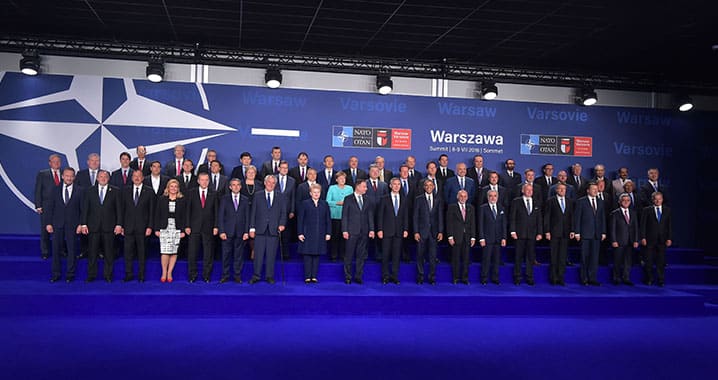
At the NATO Summit in Warsaw in July 2016, Allied leaders sent a clear message that NATO is responding to the changed security environment by enhancing its deterrence and defence posture, while remaining open to political dialogue with Russia. © NATO
In 1956 there were hopes for less tension in Europe. Stalin was dead, Khrushchev had recently made his speech to the 20th Party Congress in Moscow denouncing the crimes of Stalin, the Soviet Union seemed to be moving towards détente, West Germany had just joined NATO, thereby stabilising the situation between the two halves of Germany, and Hungary was experimenting with reform. So it was the right moment for NATO to probe and exploit these opportunities, even if they were dashed when the Hungarian uprising was brought to a tragic end and the Soviet Union launched Sputnik and tried once more to force the Allies out of Berlin. Nonetheless, in the mid-1960s, NATO came back to the idea of balancing defence and détente in the form of the Harmel Report. Its core idea has recently been revived in the Alliance, with the NATO Summit in Warsaw agreeing that the Harmel formula of deterrence and dialogue is also the right approach in dealing with a more adventurous and unpredictable Russia in 2016. Of course, the wise men back in the 1950s could not have foreseen the development of partnerships, relations with the United Nations, European Union and other institutions, nor the enlargement of the Alliance to so many of its former adversaries after 1990. But they led the way in stressing the non-military tools of security policy.
Adapting to new challenges
Finally, the three wise men also saw that to survive and thrive, NATO had to become less rigid and more adaptable. West Germany’s entry into NATO in 1955 had introduced a new major power into NATO’s deliberations, which might initially not have the military clout of France or the United Kingdom but which in time would become a major force in NATO politics. Southern flank members of NATO, such as Italy, Greece or Turkey, also showed that NATO needed to respond to security challenges in the Mediterranean as well as along the central front of the Fulda Gap or the Luneburg Heath in Germany.
The collapse of the European Defence Community in the French National Assembly in August 1954 had underscored that a greater European role and more equitable transatlantic burden-sharing would need to be taken forward in NATO, rather than separate European structures for at least the foreseeable future. In sum, the three wise men’s report recognised that for adaptation to be successful it has to respond to internal challenges as much as to the signals that are being received from the outside world.
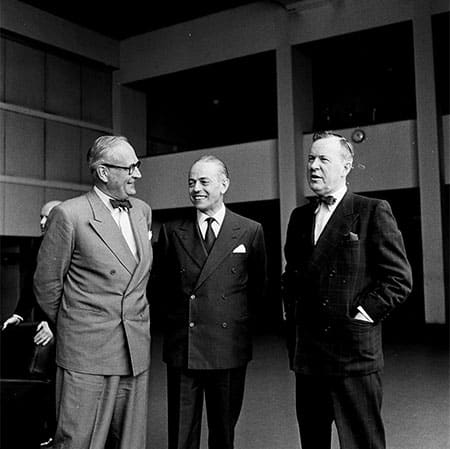
The ‘three wise men’ showed the value of taking a longer-term perspective on the evolution of the Alliance. © NATO
In conclusion, to remain relevant, NATO has from time to time to evaluate itself from the outside. It is all too easy to be consumed by the crisis “du jour” or the unrelenting agenda of weekly committee meetings. Yet to invest too much in the present is to neglect the future and the need to prepare for it now. The three wise men’s report showed the value of taking a longer-term perspective on the evolution of the Alliance. This was not only repeated in the Harmel exercise in the 1960s, but also when NATO tasked the former US Secretary of State Madeleine Albright and a group of experts to make recommendations for its new Strategic Concept in 2010.
In the turbulent world of 2016 when many of the fundamentals of transatlantic cooperation and western liberalism are again being questioned, it may not be such a bad idea for NATO leaders to turn to wise men and women for guidance, to make sure we are not losing sight of the wood for the trees and are charting a sensible course through the maze of contemporary security challenges.
